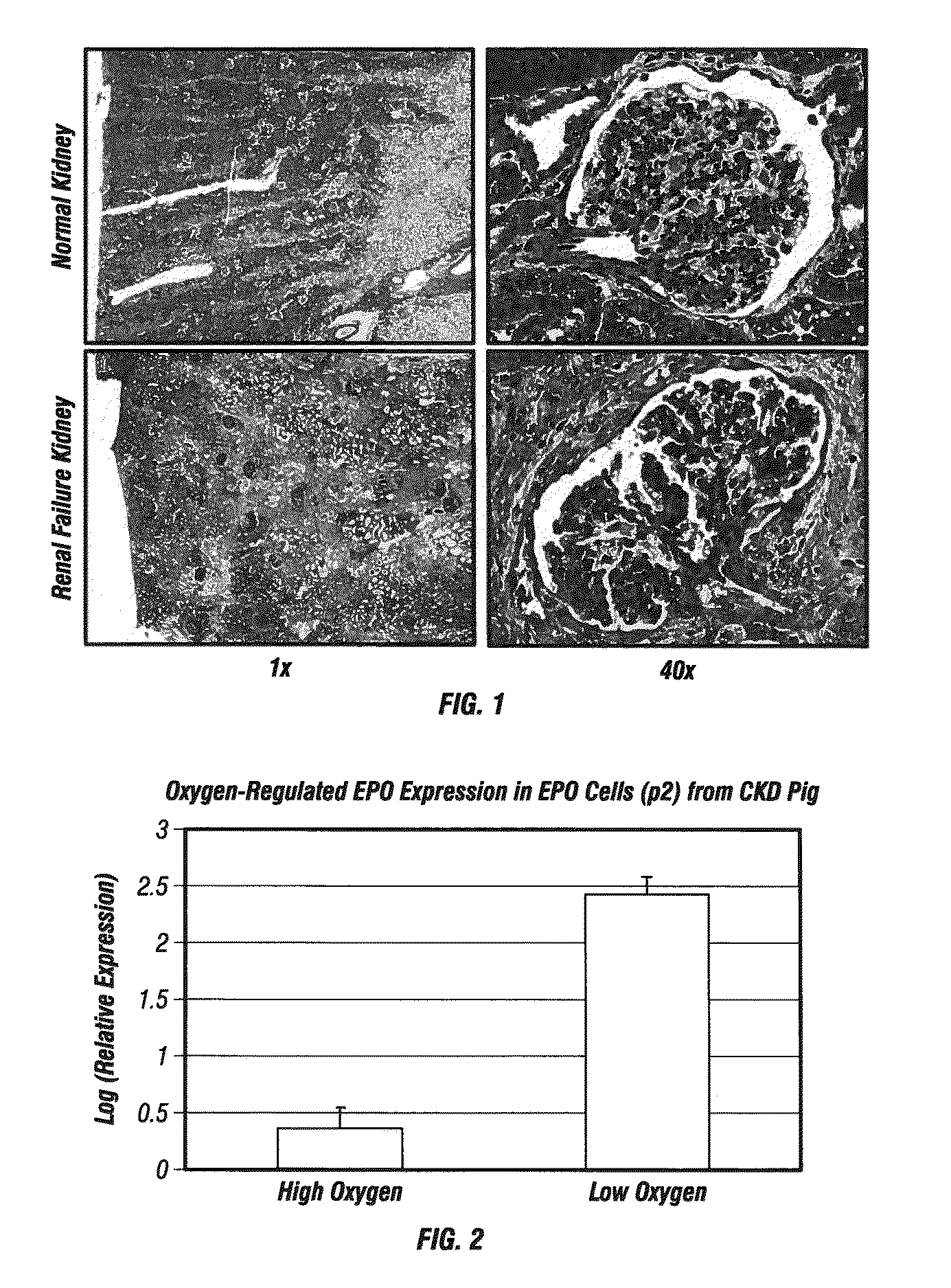Isolated renal cells and uses thereof
a technology of renal cells and isolated cells, applied in the field of isolated renal cells, can solve the problems of significant quality-of-life issues, the supply of high-quality donor kidneys cannot meet the demand for renal failure patients, and patients with renal failure experience not only the loss of kidney function (uremia), so as to reduce the decline, improve one or more renal functions, and reduce the effect of declin
- Summary
- Abstract
- Description
- Claims
- Application Information
AI Technical Summary
Benefits of technology
Problems solved by technology
Method used
Image
Examples
example 1
Isolation and Characterization of Bioresponsive Renal Cells from Adult Pig with Renal Failure
[0284]A case of idiopathic progressive chronic kidney disease (CKD) with anemia in an adult male swine (Sus scrofa) provided fresh diseased kidney tissue for the assessment of cellular composition and characterization with direct comparison to age-matched normal swine kidney tissue.
[0285]Histological examination of the kidney tissue at the time of harvest confirmed renal disease characterized by severe diffuse chronic interstitial fibrosis and crescentic glomerulonephritis with multifocal fibrosis. Clinical chemistry confirmed azotemia (elevation of blood urea nitrogen and serum creatinine), and mild anemia (mild reduction in hematocrit and depressed hemoglobin levels). Cells were isolated, expanded, and characterized from both diseased and normal kidney tissue.
[0286]FIG. 1 shows a Gomori's Trichrome stain highlighting the fibrosis (blue staining indicated by arrows) in the diseased kidney t...
example 2
Isolation of Bioresponsive EPO Cells from Human Kidney
[0291]EPO-producing cells were isolated enzymatically from normal adult human kidney (as described above in Example 1). As shown in FIG. 5, the isolation procedure resulted in more relative EPO expression after isolation than in the initial tissue. As shown in FIG. 6, it is possible to maintain the human EPO producing cells in culture with retention of EPO gene expression. Human cells were cultured / propagated on plain tissue-culture treated plastic or plastic that had been coated with some extracellular matrix, such as, for instance, fibronectin or collagen, and all were found to support EPO expression over time.
example 3
Culture of Bioresponsive EPO-Expressing and Tubular Cells from Rodent Kidney
[0292]This study analyzed in vitro EPO expression and tubular marker expression in response to hypoxia and shear forces using primary kidney cells isolated from Lewis rats.
[0293]Primary kidney cells were isolated from Lewis rats using standard methods adapted from mouse (Aboushwareb et al., 2008. World J. Urol. August; 26(4):295-300), and propagated in low vs. high oxygen or static vs. dynamic 3D culture.
[0294]The oxygen-dependency of Epo-producing cells was determined by culturing cells under atmospheric “normoxic” culture conditions (37° C. incubator equilibrated to 21% O2, 5% CO2) and then lowering the oxygen-tension to hypoxic culture (37° C. incubator equilibrated to 2% O2, 5% CO2) in order to activate low-oxygen-dependent gene transcription of Epo. A final switch back to normoxic conditions would inhibit the gene transcription that occurred under hypoxic conditions. Primary kidney cells were cultured o...
PUM
| Property | Measurement | Unit |
|---|---|---|
| density | aaaaa | aaaaa |
| density | aaaaa | aaaaa |
| density | aaaaa | aaaaa |
Abstract
Description
Claims
Application Information
 Login to View More
Login to View More - R&D
- Intellectual Property
- Life Sciences
- Materials
- Tech Scout
- Unparalleled Data Quality
- Higher Quality Content
- 60% Fewer Hallucinations
Browse by: Latest US Patents, China's latest patents, Technical Efficacy Thesaurus, Application Domain, Technology Topic, Popular Technical Reports.
© 2025 PatSnap. All rights reserved.Legal|Privacy policy|Modern Slavery Act Transparency Statement|Sitemap|About US| Contact US: help@patsnap.com



